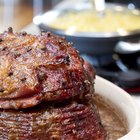
Sometimes you can break tradition and still keep things traditional. Take souvlaki, for example. Skewered, bite-sized pieces of pork shoulder cooked on a grill and served on a pita with fresh tomatoes, onions, feta and tzatziki -- everything about the dish resonates traditional Greek cuisine. But you don't have to break out the grill -- or visit the Mediterranean -- every time you want to indulge in authentic-tasting souvlaki. Oven-roasting gets the pork to the same place the grill does -- tender and light, yet layered with flavor -- but without all the char and smoke.
Step 1
Trim any loose, hanging fat from the pork shoulder with a kitchen knife. If the pork has the skin and a thick fat layer still attached to one side, as some market-form pork shoulders do, peel it away from the meat while slicing between the fat and meat with the kitchen knife. It should come off in one piece easily.
Step 2
Cut the pork into 1-inch cubes and place them in a shallow dish.
Step 3
Prepare a marinade. Traditional souvlaki marinades comprise olive oil, lemon juice, dried oregano and mint, salt, pepper and sometimes minced garlic and a Turkish bay leaf. You can make your own marinade using two parts olive oil to one part acid, such as lemon juice, as the base, and adding herbs and spices to taste.
Step 4
Pour the marinade over the pork. Stir the pork cubes in the marinade to coat. Cover the dish with plastic wrap and place it on the bottom shelf of the refrigerator. Marinating raw meat on the bottom shelf of the refrigerator prevents it from cross-contaminating other foods should it get bumped or spilled.
Step 5
Marinate the pork for three to four hours, stirring it after about two hours. Remove the pork from the fridge and let it reach room temperature.
Step 6
Remove the pork cubes from the marinade and place them on a plate. Blot the cubes with a paper towel to absorb excess marinade if it contains a lot of salt or sugar. Marinades reduce when cooked, so if your marinade is salty, the souvlaki will taste even saltier. Sugar burns at oven-searing temperatures, so you should remove any excess, if applicable.
Step 7
Heat the oven to 500 degrees Fahrenheit. Roasting pork at a high temperature for a few minutes, or oven-searing it, produces a caramelized exterior you can't get with low heat.
Step 8
Transfer the pork from the plate to a shallow baking dish. Place the dish in the oven.
Step 9
Oven-sear the pork at 500 F until it develops a golden-brown crust, or about five minutes. Lower the heat to 325 F.
Step 10
Roast the souvlaki at 325 F for about 15 to 20 minutes, or until cooked through. Check the doneness by slicing a piece or two through the center and checking visually, or sliding four or five piece on the probe of a meat thermometer and checking the temperature. Fully cooked pork has no traces of pink inside and has an internal temperature of 145 F.
Related Articles

How to Cook Pork Hamonado

How to Make Asado Chinese Style

How to Braise Pork

How to Cook Pork Chops on an Electric ...

Reheating a BBQ Pork Shoulder

How to Cook Barbecue Deer in the Slow ...

How to Use a Roaster for Pork

How to Tell If a Pork Roast is Done

How to Roast a Pork Blade Cut

How to Make Filipino Pork Adobo

How Do I Tell If Pork Has Turned Bad?

Barbecue Tips for Pork Rib Brisket

How to Cook With Pork Jowl

How to Cook a Pork Neck Fillet

How to Cook Bone-In Pork Strips in the ...

How to Cook Pork Shoulder Strips

How to Cook Axis Deer Steaks

How to Bake a Smithfield Spiral Ham

How to Cook Muskrat

How to BBQ Ribs on a Smoker
References
- The Deluxe Food Lover's Companion; Sharon Tyler Herbst and Ron Herbst, Alexander Spare
Tips
- You can substitute lamb, beef or chicken for pork. Follow the same technique.
Writer Bio
A.J. Andrews' work has appeared in Food and Wine, Fricote and "BBC Good Food." He lives in Europe where he bakes with wild yeast, milks goats for cheese and prepares for the Court of Master Sommeliers level II exam. Andrews received formal training at Le Cordon Bleu.
Photo Credits
Stockbyte/Stockbyte/Getty Images